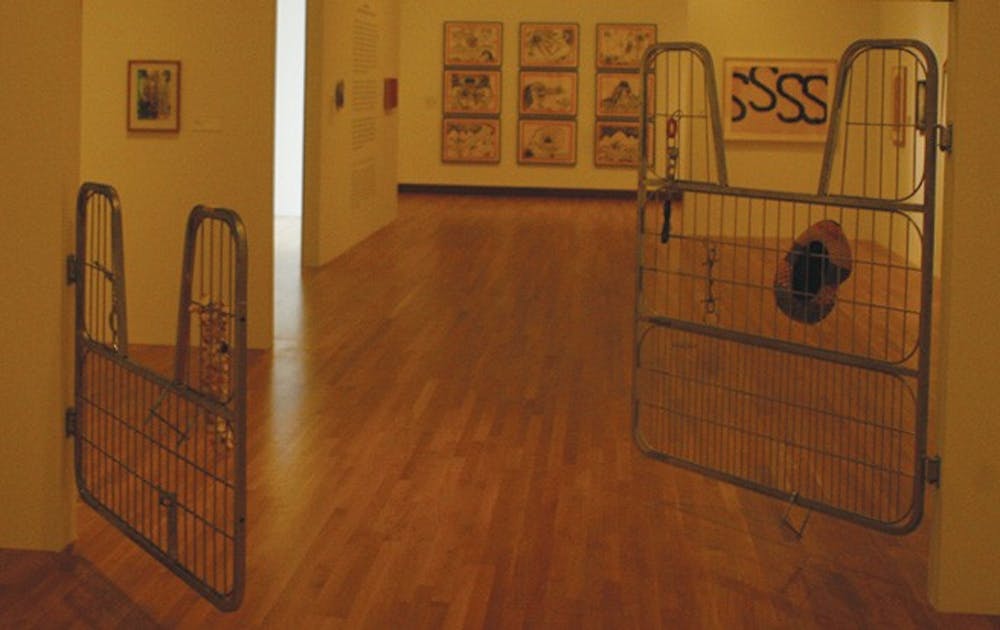The new exhibit on display at the Nasher Museum of Art is impressive for many reasons: not just for the tart lemon meringue yellow of Michael Jenkins’ Untitled (Gate) or for the humorous Richard Prince prints that ring of sexual frustration and consumerism or the daring Story of Jason by Keith Haring that smoothly inserts itself into the mind like a splinter for long afterwards, but rather the fact—probably more disturbing than Haring’s piece—that this collection was started by a thirteen-year-old kid.
For its 20th anniversary re-release, Time Capsule, formerly known as Age 13 to 21: The Contemporary Art Collection of Jason Rubell, is once again on rotation at the ten schools at which it originally appeared.
Jason Rubell, a Duke alum and now one of the world’s foremost contemporary art collectors, obtained his first piece of serious art when he was thirteen, and spent the next nine years forming the collection. To purchase the art, he used money from his tennis racquet stringing business and holidays.
“Any time a birthday or a holiday would roll around I would make everyone keenly aware that what I wanted was not some silly, predictable adolescent gift, but instead assistance with my art purchases,” Rubell wrote in the catalogue released for the show.
On the phone, Rubell cited the importance of the role his parents played in inspiring him to pursue art collecting.
“I hope that in time, my children will have the same passion their parents have for art, as my parents had before me,” he said.
Rubell also noted the importance that Duke played in his development. He knew coming into Duke that he wanted to be an art history major, and early on in his academic career had the good fortune of meeting France Family Professor of Art, Art History & Visual Studies Kristine Stiles, who is a still a member of the department. In 1990, with the help of Professor Stiles, Rubell exhibited his collection as a senior project at the Duke University Museum of Art (DUMA).
When choosing pieces for his collection, Rubell showed astounding foresight: the exhibition contains what are now some of the biggest names in contemporary art. This includes, but is not limited to, Michael Jenkins, now a senior partner at the prestigious Sikkema Jenkins & Co. gallery in Manhattan, the aforementioned Keith Haring, who designed Rubell’s bar-mitzvah invitations, Jeff Koons, Cindy Sherman, Jenny Holzer and Sol LeWitt. At the time of purchase, however, many of the artists in the collection were unknown. Rubell laughs at how many people threw away his Keith Haring-designed bar-mitzvah invitations, only to call back years later with requests for another one.
Today, Rubell collects art through the Rubell Family Collection, based in Miami, Florida. In his free time, he has been traveling to university museums that have exhibited the collection and speaking with students. In these talks, Rubell has found that students are interested in how to repeat his success.
“If you are truly interested in collecting art, you have to make a sacrifice,” he said. “Try drinking one less cup of coffee a day or save the bus fare to school and ride your bike.”
He also tells students to “get informed,” noting how he subscribed to Parkett magazine to learn more about trends in the art world.
More importantly, however, Rubell wants students to know that art collecting is not just about value. “You don’t have to acquire anything famous. Art collecting is about finding something through your exploration that you find appealing,” he said. “If something appeals to you, and it does become famous, great, but if it doesn’t you still have that personal connection with the piece. For a relatively small amount, one can take a journey.”
Time Capsule runs until January 6. In addition to the exhibit, Jason Rubell will give a talk Wednesday, September 5 at 7 p.m. at the Nasher. A free film series complementing the exhibit will also run every Thursday at 7 p.m. from September 6 to September 27.
Get The Chronicle straight to your inbox
Signup for our weekly newsletter. Cancel at any time.

